Economic Assessment of Urban Ash Tree Management Options in New Jersey
Abstract
1. Introduction
- To quantify the economic value of ecosystem services, including storm water, property value, energy, CO2 and air quality by ash tree.
- To conduct a net present value analysis of future benefits and costs for each of the four EAB management scenarios.
2. Material and Methods
2.1. Case Study
2.2. Ash Tree Age, DBH and Growth Rate
2.3. Costs
2.4. Ecological Benefits of Urban Ash Trees
2.5. Analysis of Management Scenarios
2.5.1. No Infestation
2.5.2. Infestation and No Action
2.5.3. Immediate Removal and Replacement
2.5.4. Treatment of Ash Trees
3. Results
3.1. Ash Tree Age, DBH and Growth Rate
3.2. Ash Tree Benefits
3.3. Costs
3.4. EAB Management Scenarios
3.4.1. No Infestation (Baseline Scenario)
3.4.2. Infestation and No Action
3.4.3. Immediate Removal and Replacement
3.4.4. Treatment of Ash Trees
4. Discussion
5. Conclusions
Author Contributions
Funding
Institutional Review Board Statement
Informed Consent Statement
Acknowledgments
Conflicts of Interest
References
- Wei, X.; Reardon, R.; Wu, Y.; Sun, J.-H. Emerald ash borer, Agrilus planipennis Fairmaire (Coleoptera: Buprestidae), in China: A review and distribution survey. Acta Entomol. Sin. 2004, 47, 679–685. [Google Scholar]
- Zhao, T.-H.; Gao, R.-T.; Liu, H.-P.; Bauer, L.S.; Sun, L. Host range of emerald ash borer, Agrilus planipennis Fairmaire, its damage and the countermeasures. Acta Entomol. Sin. 2005, 48, 594–599. [Google Scholar]
- Baranchikov, Y.N.; Mozolevskaya, E.G.; Yurchenko, G.I.; Kenis, M. Occurrence of the emerald ash borer, Agrilus planipennis in Russia and its potential impact on European forestry. Eppo Bull. 2008, 38, 233–238. [Google Scholar] [CrossRef]
- Jendek, E.; Grebennikov, V.V. Agrilus (Coleoptera, Buprestidae) of East Asia; Jan Farkac: Prague, Czech Republic, 2011; 362p. [Google Scholar]
- Flower, C.E.; Lynch, D.J.; Knight, K.S.; Gonzalez-Meler, M.A. Biotic and abiotic drivers of sap flux in mature green ash trees (Fraxinus pennsylvanica) experiencing varying levels of emerald ash borer (Agrilus planipennis) infestation. Forests 2018, 9, 301. [Google Scholar] [CrossRef]
- Eyyüb, Y.; Kıbış, İ.; Büyüktahtakın, E.; Haight, R.G.; Akhundov, N.; Knight, K.; Flower, C.E. A multistage stochastic programming approach to the optimal surveillance and control of the emerald ash borer in cities. INFORMS J. Comput. 2020, 33, 808–834. [Google Scholar]
- Cappaert, D.; DG McCullough, T.M.; Siegert, N.W. Emerald ash borer in North America: A research and regulatory challenge. Am. Entomol. 2005, 51, 152–165. [Google Scholar] [CrossRef]
- Haack, R.A. Exotic bark and wood-boring Coleoptera in the United States: Recent establishments and interceptions. Can. J. For. Res. 2006, 36, 269–288. [Google Scholar] [CrossRef]
- MacFarlane, D.W.; Meyer, S.P. Characteristics and distribution of potential ash tree hosts for emerald ash borer. For. Ecol. Manag. 2005, 213, 15–24. [Google Scholar] [CrossRef]
- Pugh, S.A.; Liebhold, A.M.; Morin, R.S. Changes in ash tree demography associated with emerald ash borer invasion, indicated by regional forest inventory data from the Great Lakes States. Can. J. For. Res. 2011, 41, 2165–2175. [Google Scholar] [CrossRef]
- Flower, C.E.; Knight, K.S.; Gonzalez-Meler, M.A. Impacts of the emerald ash borer (Agrilus planipennis Fairmaire) induced ash (Fraxinus spp.) mortality on forest carbon cycling and successional dynamics in the eastern United States. Biol. Invasions 2013, 15, 931–944. [Google Scholar] [CrossRef]
- Burns, R.; Honkala, B. Silvics of North America. Hardwoods; Agriculture Handbook 654; United States Department of Agriculture Forest Service: Washington, DC, USA, 1990; Volume 2.
- New Jersey EAB Task Force. Department of Agriculture, State of New Jersey. 2017. Available online: http://www.nj.gov/agriculture/divisions/pi/prog/eabcontacts.html (accessed on 4 February 2021).
- Siegert, N.W.; McCullough, D.G.; Liebhold, A.M.; Telewski, F.W. Dendrochronological reconstruction of the epicentre and early spread of emerald ash borer in North America. Divers. Distrib. 2014, 20, 847–858. [Google Scholar] [CrossRef]
- BenDor, T.K.; Metcalf, S.S.; Fontenot, L.E.; Sangunett, B.; Hannon, B. Modeling the spread of the emerald ash borer. Ecol. Model. 2006, 197, 221–236. [Google Scholar] [CrossRef]
- Anulewicz, A.C.; McCullough, D.G.; Cappaert, D.L.; Poland, T.M. Host range of the emerald ash borer (Agrilus planipennis Fairmaire) (Coleoptera: Buprestidae) in North America: Results of multiple-choice field experiments. Environ. Entomol. 2008, 37, 230–241. [Google Scholar] [CrossRef]
- USDA–APHIS/ARS/FS. Emerald Ash Borer Biological Control Release and Recovery Guidelines; USDA–APHIS–ARS-FS: Riverdale, MD, USA, 2017.
- Liu, H. Under Siege: Ash management in the wake of the emerald ash borer. J. Integr. Pest Manag. 2018, 9, 5. [Google Scholar] [CrossRef]
- Wang, X.-Y.; Yang, Z.-Q.; Gould, J.R.; Zhang, Y.-N.; Liu, G.-J.; Liu, E.-S. The biology and ecology of the emerald ash borer, Agrilus planipennis, in China. J. Insect Sci. 2010, 10, 128. [Google Scholar] [CrossRef]
- McCullough, G.D.; Siegert, N.W. Estimating potential emerald ash borer (Coleoptera: Buprestidae) populations using ash inventory data. J. Econ. Entomol. 2007, 100, 1577–1586. [Google Scholar] [CrossRef]
- Knight, K.S.; Brown, J.P.; Long, R.P. Factors affecting the survival of ash (Fraxinus spp.) trees infested by emerald ash borer (Agrilus planipennis). Biol. Invasions 2013, 15, 371–383. [Google Scholar] [CrossRef]
- Morin, R.S.; Pugh, S.A.; Liebhold, A.M.; Crocker, S.J. A regional assessment of emerald ash borer impacts in the Eastern United States: Ash mortality and abundance trends in time and space. In Proceedings of the Pushing Boundaries: New Directions in Inventory Techniques and Applications: Forest Inventory and Analysis (FIA) Symposium 2015, Portland, OR, USA, 8–10 December 2015; pp. 233–236. [Google Scholar]
- Taylor, R.A.J.; Bauer, L.S.; Therese, M.; Windell, K.N. Flight performance of Agrilus planipennis (Coleoptera: Buprestidae) on a flight mill and in free flight. J. Insect Behavior 2010, 23, 128–148. [Google Scholar] [CrossRef]
- Herms, D.A.; McCullough, D.G. Emerald ash borer invasion of North America: History, biology, ecology, impact and management. Annu. Rev. Entomol. 2014, 59, 13–30. [Google Scholar] [CrossRef]
- Prasad, A.M.; Iverson, L.R.; Peters, M.P.; Bossenbroek, J.M.; Matthews, S.N.; Sydnor, T.D.; Schwartz, M.W. Modeling the invasive emerald ash borer risk of spread using a spatially explicit cellular model. Landsc. Ecol. 2010, 25, 353–369. [Google Scholar] [CrossRef]
- Aukema, J.; Leung, B.; Kovacs, K.; Chivers, C.; Britton, K.O.; Englin, J.; Frankel, S.J.; Haight, R.G.; Holmes, T.P.; Leibhold, A.M.; et al. Economic impacts of non-native forest insects in the United States. PLoS ONE 2011, 6, e24587. [Google Scholar] [CrossRef] [PubMed]
- Heffelfinger, K. A Discounted Cash Flow Method of Valuation for Single Trees and Urban Forests. Master’s Thesis, Clemson University, Clemson, SC, USA, May 2010. [Google Scholar]
- Dwyer, J.F.; Schroeder, H.W.; Gobster, P.H. The significance of urban trees and forests: Towards a deeper understanding of values. J. Arboric. 1991, 17, 276–284. [Google Scholar]
- McPherson, E.G. Accounting for benefits and costs of urban greenspace. Landsc. Urban Plan. 1992, 22, 41–51. [Google Scholar] [CrossRef]
- McPherson, E.G. Benefit-based tree valuation. Arboric. Urban For. 2007, 33, 1–11. [Google Scholar] [CrossRef]
- Peterson, S.K.; Straka, J.T. Urban forest and tree valuation using discounted cash flow analysis: Impact of economic components. Open J. For. 2012, 2, 174. [Google Scholar] [CrossRef][Green Version]
- Cullen, S. Putting a value on trees: CTLA guidance and methods. Arboric. J. 2007, 30, 21–43. [Google Scholar] [CrossRef]
- Tyrväinen, L.; Miettinen, A. Property prices and urban forest amenities. J. Environ. Econ. Manag. 2000, 39, 206–223. [Google Scholar] [CrossRef]
- Council of Tree and Landscape Appraisers (CTLA). Guide for Plant Appraisal, 10th ed.; ISA: Atlanta, GA, USA, 2020; 170p. [Google Scholar]
- Nowak, D.J.; Greenfield, E.J. US urban forest statistics, values, and projections. J. For. 2018, 116, 164–177. [Google Scholar] [CrossRef]
- Escobedo, F.J.; Adams, D.C.; Timilsina, N. Urban forest structure effects on property value. Ecosyst. Services 2015, 12, 209–217. [Google Scholar] [CrossRef]
- McPherson, E.G.; Simpson, J.R. Potential energy saving in buildings by an urban tree planting program in California. Urban For. Urban Green. 2003, 3, 73–86. [Google Scholar] [CrossRef]
- McPherson, E.G.; Xiao, Q.; Aguaron, E. A new approach to quantify and map carbon stored: Sequestered and emissions avoided by urban forests. Landsc. Urban Plan. 2013, 120, 70–84. [Google Scholar] [CrossRef]
- Nowak, D.J.; Greenfield, E.J.; Hoehn, R.E.; Lapointe, E. Carbon storage and sequestration by trees in urban and community areas of the United States. Environ. Pollut. 2013, 178, 229–236. [Google Scholar] [CrossRef] [PubMed]
- McPherson, E.G.; Xiao, Q.; van Doorn, N.S.; de Goede, J.; Bjorkman, J.; Hollander, A.; Boynton, R.M.; Quinn, J.F.; Thorne, J.H. The structure, function and value of urban forests in California communities. Urban For. Urban Green. 2017, 28, 43–53. [Google Scholar] [CrossRef]
- Jones, R.; Davis, K.; Bradford, J. The value of trees: Factors influencing homeowner support for protecting local urban trees. Environ. Behav. 2013, 45, 650–676. [Google Scholar] [CrossRef]
- Gatto, P.; Vidale, E.; Secco, L.; Pettenella, D. Exploring the willingness to pay for forest ecosystem services by residents of the Veneto region. Bio. Based Appl. Econ. 2014, 3, 21–43. [Google Scholar] [CrossRef]
- Tolunay, A.; Bassullu, C. Willingness to pay for carbon sequestration and co-benefits of forests in Turkey. Sustainability 2015, 7, 3311–3337. [Google Scholar] [CrossRef]
- Willis, K.G.; Garrod, G.D. An individual travel-cost method of evaluating forest recreation. J. Agric. Econ. 1991, 42, 33–42. [Google Scholar] [CrossRef]
- Pak, M.; Turker, M.F. Estimation of recreational use value of forest resources by using individual travel cost and contingent valuation methods (Kayabasi forest recreation site sample). J. Appl. Sci. 2006, 6, 1–5. [Google Scholar] [CrossRef]
- Sadof, C.S.; Purcell, L.; Bishop, F.J.; Quesada, C.; Zhang, Z. Evaluating restoration capacity and costs of managing the emerald ash borer with a web-based cost calculator in urban forests. Arboric. Urban For. 2011, 37, 74–83. [Google Scholar] [CrossRef]
- Sadof, C.S.; Hughes, G.P.; Witte, A.R.; Peterson, D.J.; Ginzel, M.D. Tools for staging and managing emerald ash borer in the urban forest. Arboric. Urban For. 2017, 43, 15–26. [Google Scholar] [CrossRef]
- Casey Trees and Davey Tree Expert Company. National Tree Benefit Calculator. 2021. Available online: http://treebenefits.com/calculator (accessed on 12 October 2021).
- Hauer, R.J.; Vogt, J.M.; Fischer, B.C. The cost of not maintaining the urban forest. Arborist News. 2015, 24, 12–17. [Google Scholar]
- Emerald Ash Borer. 2021. Available online: https://www.nj.gov/agriculture/divisions/pi/prog/emeraldashborer.html (accessed on 12 November 2021).
- Kovacs, K.F.; Haight, R.G.; McCullough, D.G.; Mercader, R.J.; Siegert, N.W.; Liebhold, A.M. Cost of potential emerald ash borer damage in U.S. communities, 2009–2019. Ecol. Econ. 2010, 69, 569–578. [Google Scholar] [CrossRef]
- Zipse, P.; Grabosky, J. Preparing for Emerald Ash Borer: Department of Agriculture, State of New Jersey. 2015. Available online: http://www.nj.gov/agriculture/divisions/pi/pdf/preppingforeabarticle.pdf (accessed on 12 December 2020).
- Rapid Ash Survey Project, Rutgers & New Jersey State Forest Service. Rutgers & NJ State Forest Service Rapid Ash Survey Project. 2015. Available online: http://www.nj.gov/agriculture/divisions/pi/prog/eabcommunties.html#4 (accessed on 15 November 2021).
- Colbert, J.J.; Schuckers, M.; Fekedulegn, D. Comparing models for growth and management of forest tracts. Modelling Forest Systems. In Proceedings of the Workshop on the Interface between Reality, Modelling and the Parameter Estimation Processes, Sesimbra, Portugal, 2–5 June 2002; pp. 335–346. [Google Scholar] [CrossRef]
- Colbert, J.J.; Schuckers, M.; Fekedulegn, D.; Rentch, J.; MacSiúrtáin, M.; Gottschalk, K. Individual tree basal-area growth parameter estimates for four models. Ecol. Model. 2004, 174, 115–126. [Google Scholar] [CrossRef]
- Li, R.; Stewart, B.; Weiskittel, A. A Bayesian approach for modelling non-linear longitudinal/hierarchical data with random effects in forestry. Forestry 2012, 85, 17–25. [Google Scholar] [CrossRef]
- González-García, M.; Hevia, A.; Majada, J.; Calvo de Anta, R.; Barrio-Anta, M. Dynamic growth and yield model including environmental factors for Eucalyptus nitens (Deane & Maiden) Maiden short rotation woody crops in Northwest Spain. New For. 2015, 46, 387–407. [Google Scholar] [CrossRef]
- Lunn, D.J.; Thomas, A.; Best, N.; Spiegelhalter, D. WinBUGS—A Bayesian modelling framework: Concepts, structure, and extensibility. Stat. Comput. 2000, 10, 325–337. [Google Scholar] [CrossRef]
- Lovallo, G.; Grabosky, J. New Jersey Species Rating Guide, 3rd ed.; International Society of Arboriculturem: Atlanta, GA, USA, 2015. [Google Scholar]
- Klooster, W.S.; Herms, D.A.; Knight, K.S.; Herms, C.P.; McCullough, D.G.; Smith, A.; Cardina, J. Ash (Fraxinus spp.) mor-tality, regeneration, and seed bank dynamics in mixed hardwood forests following invasion by emerald ash borer (Agrilus planipennis). Biol. Invasions 2014, 16, 859–873. [Google Scholar] [CrossRef]
- Burr, S.J.; McCullough, D.G. Condition of green ash (Fraxinus pennsylvanica) overstory and regeneration at three stages of the emerald ash borer invasion wave. Can. J. For. Res. 2014, 44, 768–776. [Google Scholar] [CrossRef]
- Smith, A.; Herms, D.; Long, R.; Gandhi, K. Community composition and structure had no effect on forest susceptibility to invasion by the emerald ash borer (Coleoptera: Buprestidae). Can. Entomol. 2015, 147, 318–328. [Google Scholar] [CrossRef]
- Morin, R.S.; Liebhold, A.M.; Pugh, S.A.; Crocker, S.J. Regional assessment of emerald ash borer, Agrilus planipennis, impacts in forests of the Eastern United States. Biol. Invasions 2017, 19, 703–711. [Google Scholar] [CrossRef]
- Gandhi, K.J.K.; Smith, A.; Long, R.P.; Taylor, R.A.J.; Herms, D.A. Three-year progression of emerald ash borer-induced decline and mortality in southeastern Michigan. In Proceedings of the Emerald Ash Borer Research and Development Meeting, Pittsburgh, PA, USA, 23–24 October 2007; p. 27. [Google Scholar]
- R Core Team. R: A Language and Environment for Statistical Computing; R Foundation for Statistical Computing: Vienna, Austria, 2021; Available online: https://www.R-project.org/ (accessed on 12 December 2021).
- Jenkins, J.C. Comprehensive Database of Diameter-Based Biomass Regressions for North American Tree Species; US Forest Service: Washington, DC, USA, 2004.
- McHale, M.; Burke, I.C.; Lefsky, M.A.; Peper, P.J.; McPherson, E.G. Urban forest biomass estimates: Is it important to use allometric relationships developed specifically for urban trees? Urban Ecosyst. 2009, 12, 95–113. [Google Scholar] [CrossRef]
- Magarik, Y.A.S.; Roman, L.A.; Henning, J.G. How should we measure the DBH of multi-stemmed urban trees? Urban For. Urban Green. 2020, 47, 126481. [Google Scholar] [CrossRef]
- Moser, A.; Rötzer Pauleit, T.S.; Pretzsch, H. Structure and ecosystem services of small-leaved lime (Tilia cordata Mill.) and black locust (Robinia pseudoacacia L.) in urban environments. Urban For. Urban Green. 2015, 14, 1110–1121. [Google Scholar] [CrossRef]
- Gering, L.R.; May, D.M. The relationship of diameter at breast height and crown diameter for four species in Hardin County, Tennessee. South. J. Appl. For. 1995, 19, 177–181. [Google Scholar] [CrossRef]
- Foli, E.G.; Alder, D.; Miller, H.G.; Swaine, M.D. Modelling growing space requirements for some tropical forest tree species. For. Ecol. Manag. 2003, 173, 79–88. [Google Scholar] [CrossRef]
- Sánchez-González, M.; Cañellas, I.; Montero, G. Generalized height-diameter and crown diameter prediction models for cork oak forests in Spain. For. Syst. 2007, 16, 76–88. [Google Scholar] [CrossRef]
- Fu, L.; Sun, H.; Sharma, R.P.; Lei, Y.; Zhang, H.; Tang, S. Nonlinear mixed-effects crown width models for individual trees of Chinese fir (Cunninghamia lanceolata) in south-central China. For. Ecol. Manag. 2013, 302, 210–220. [Google Scholar] [CrossRef]
- Iizuka, K.; Yonehara, T.; Itoh, M.; Kosugi, Y. Estimating Tree height and diameter at breast height (DBH) from digital surface models and orthophotos obtained with an unmanned aerial system for a Japanese cypress (Chamaecyparis obtusa) Forest. Remote. Sens. 2017, 10, 13. [Google Scholar] [CrossRef]
- Sharma, R.P.; Bílek, L.; Vacek, Z.; Vacek, S. Modelling crown width-diameter relationship for Scots pine in the central Europe. Trees 2017, 31, 1875–1889. [Google Scholar] [CrossRef]
- Yang, Y.; Huang, S. Allometric modelling of crown width for white spruce by fixed- and mixed-effects models. For. Chron. 2017, 93, 138–147. [Google Scholar] [CrossRef]
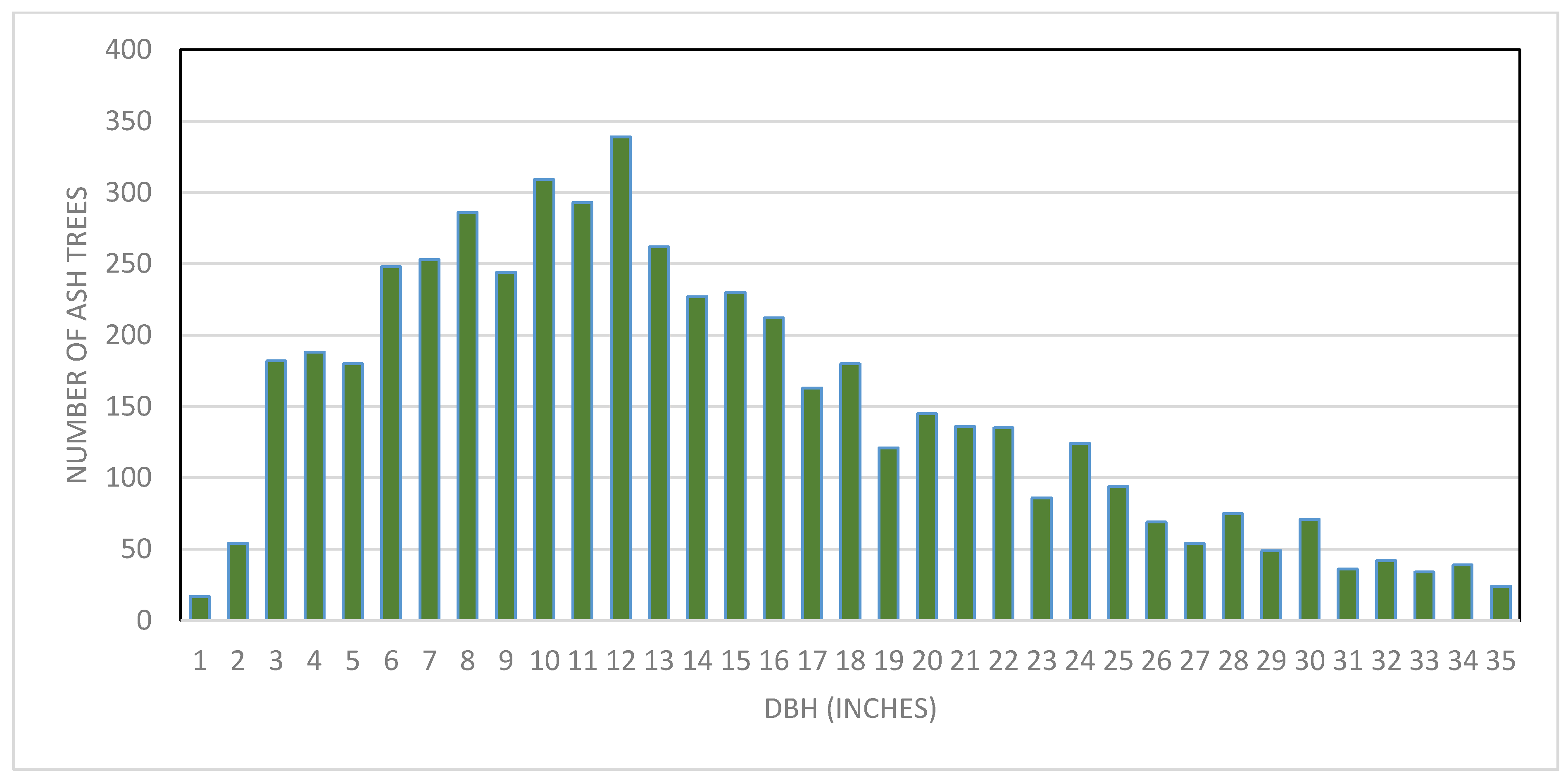
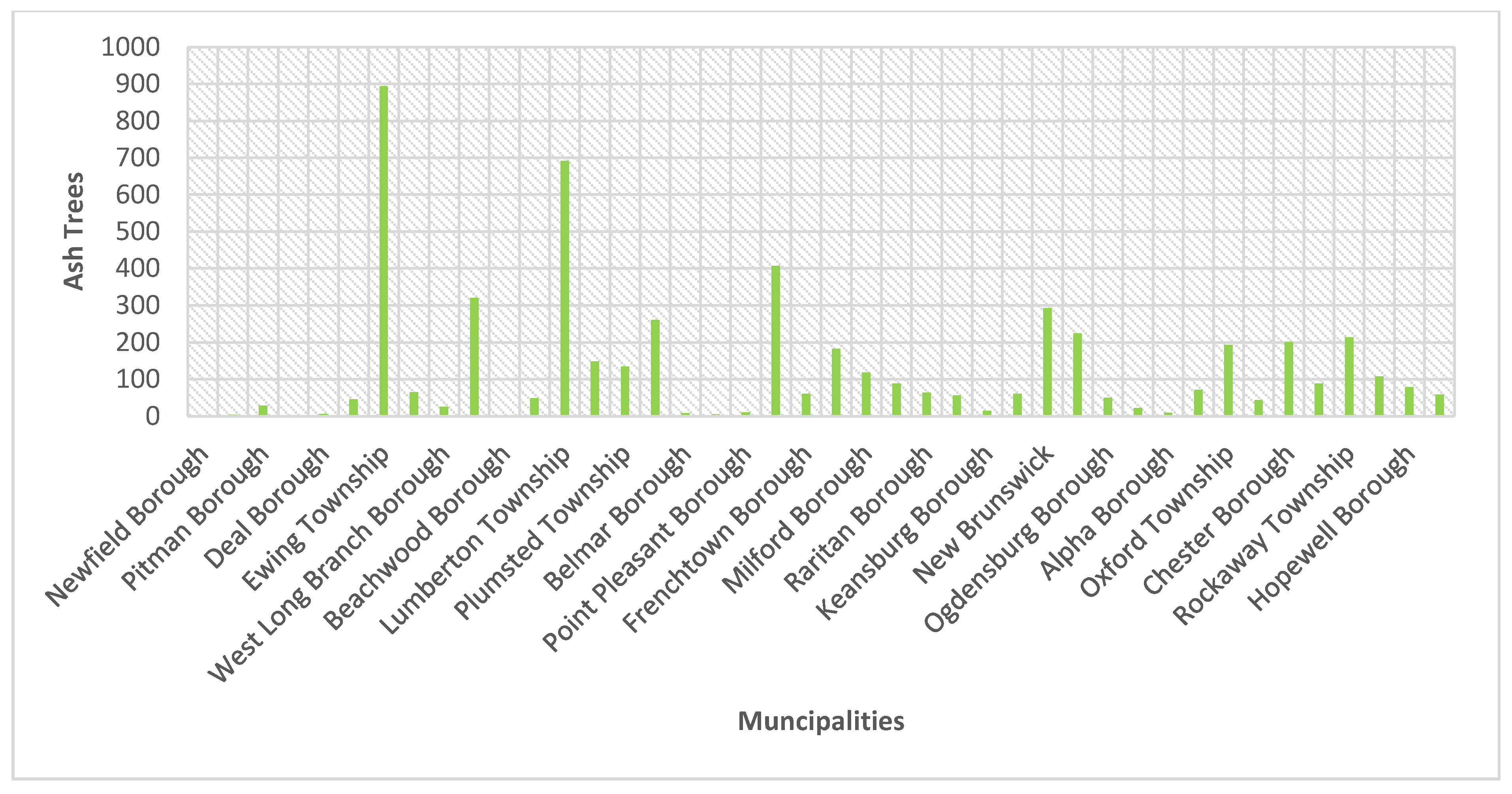
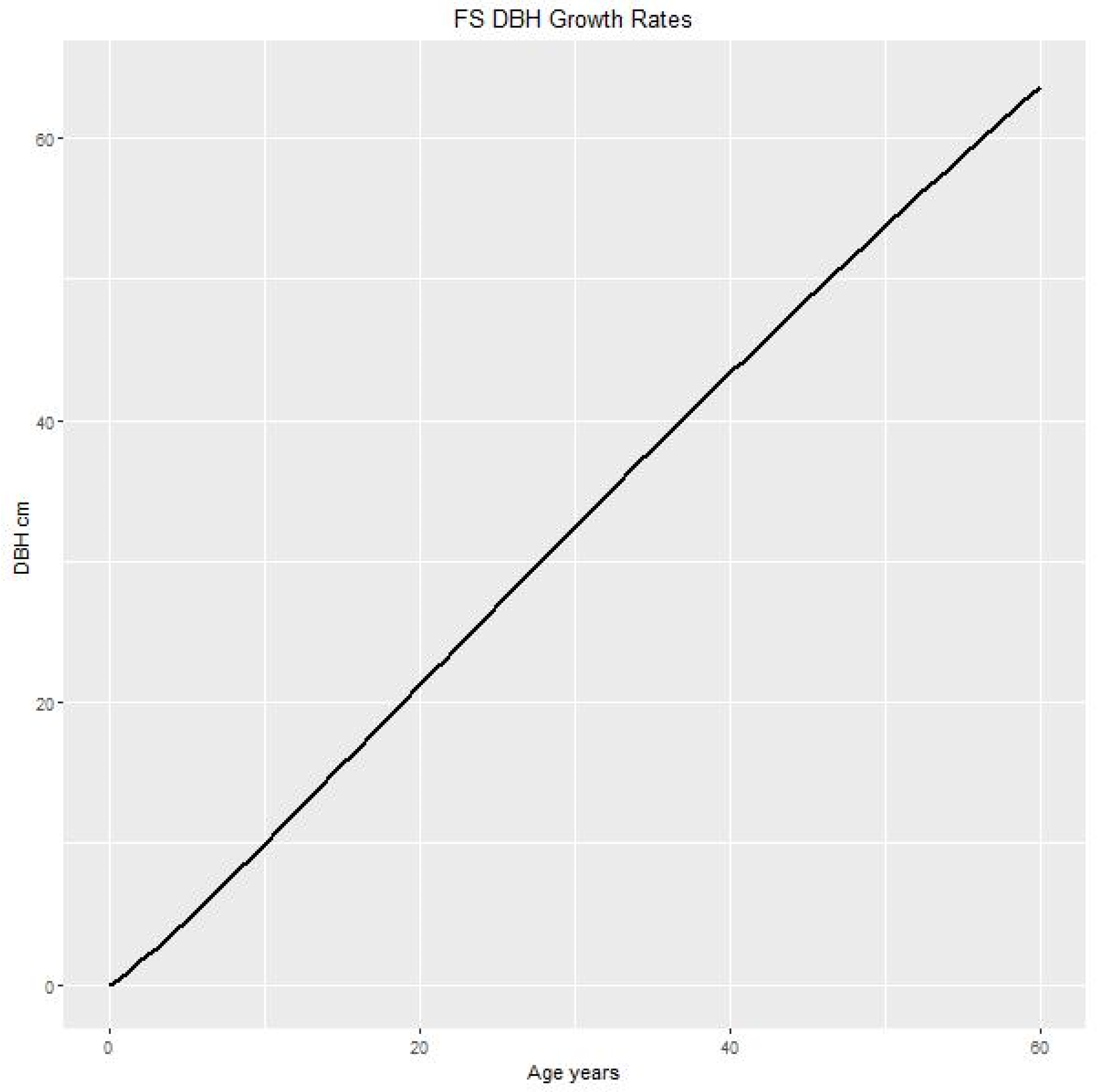
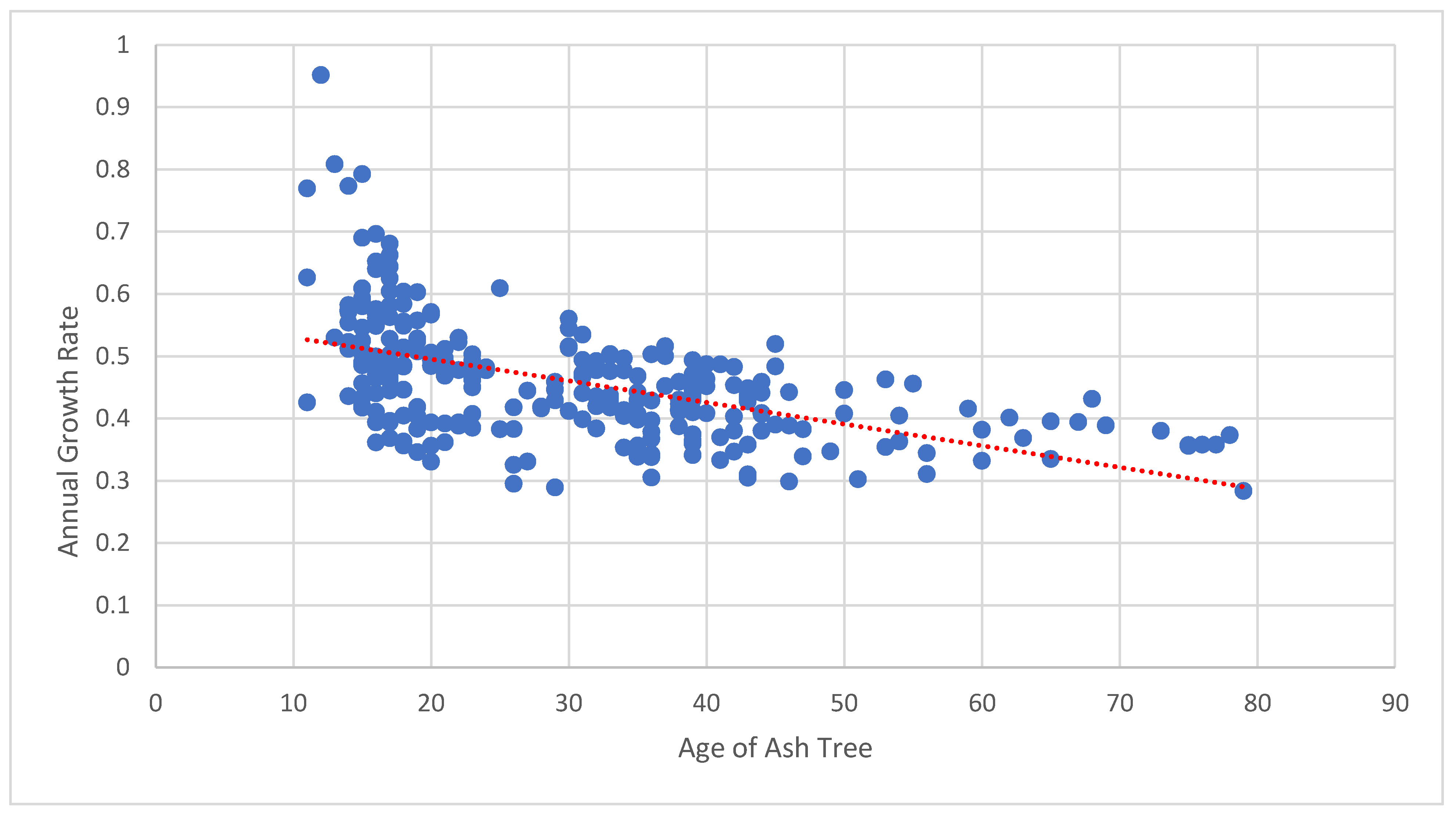
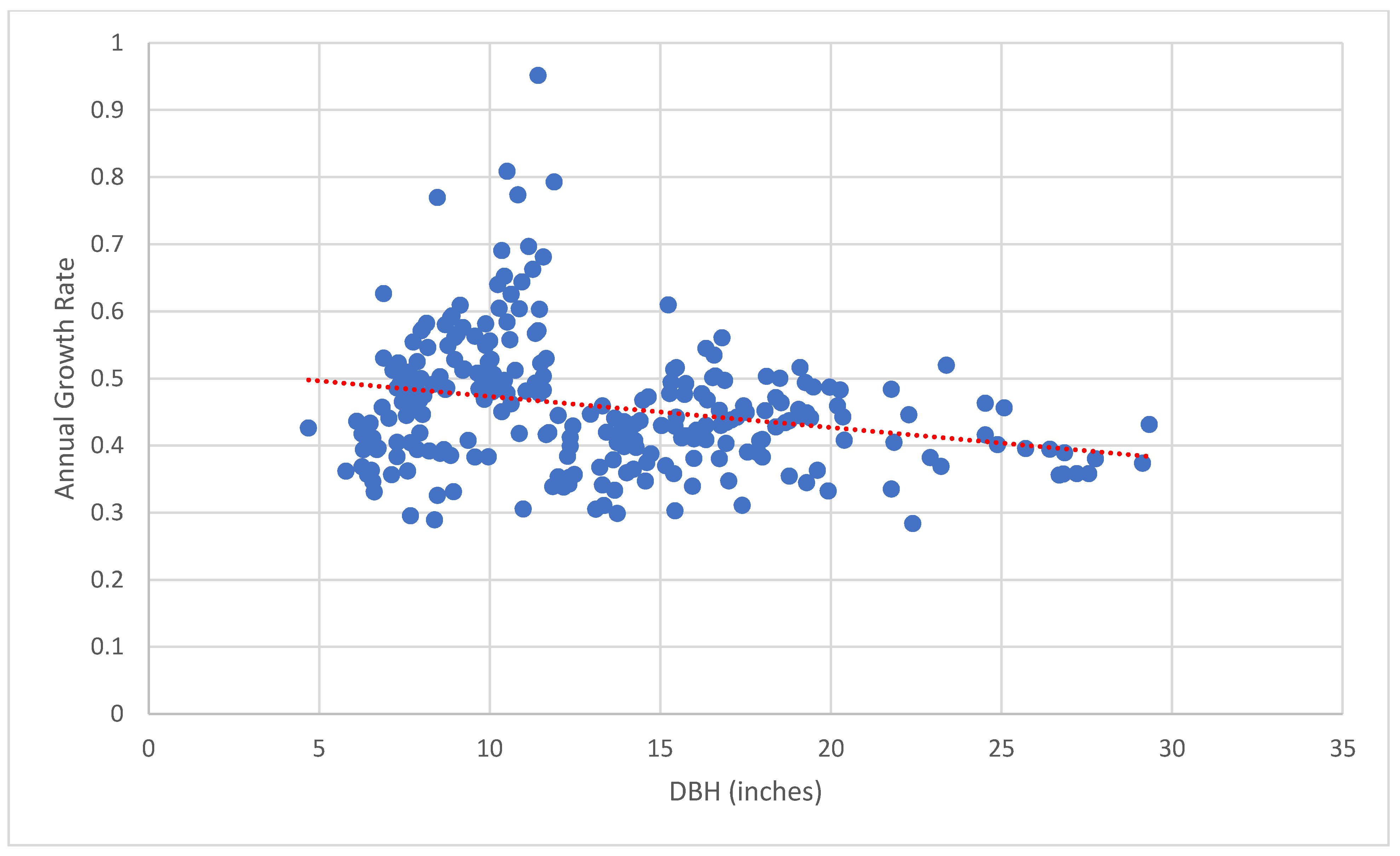
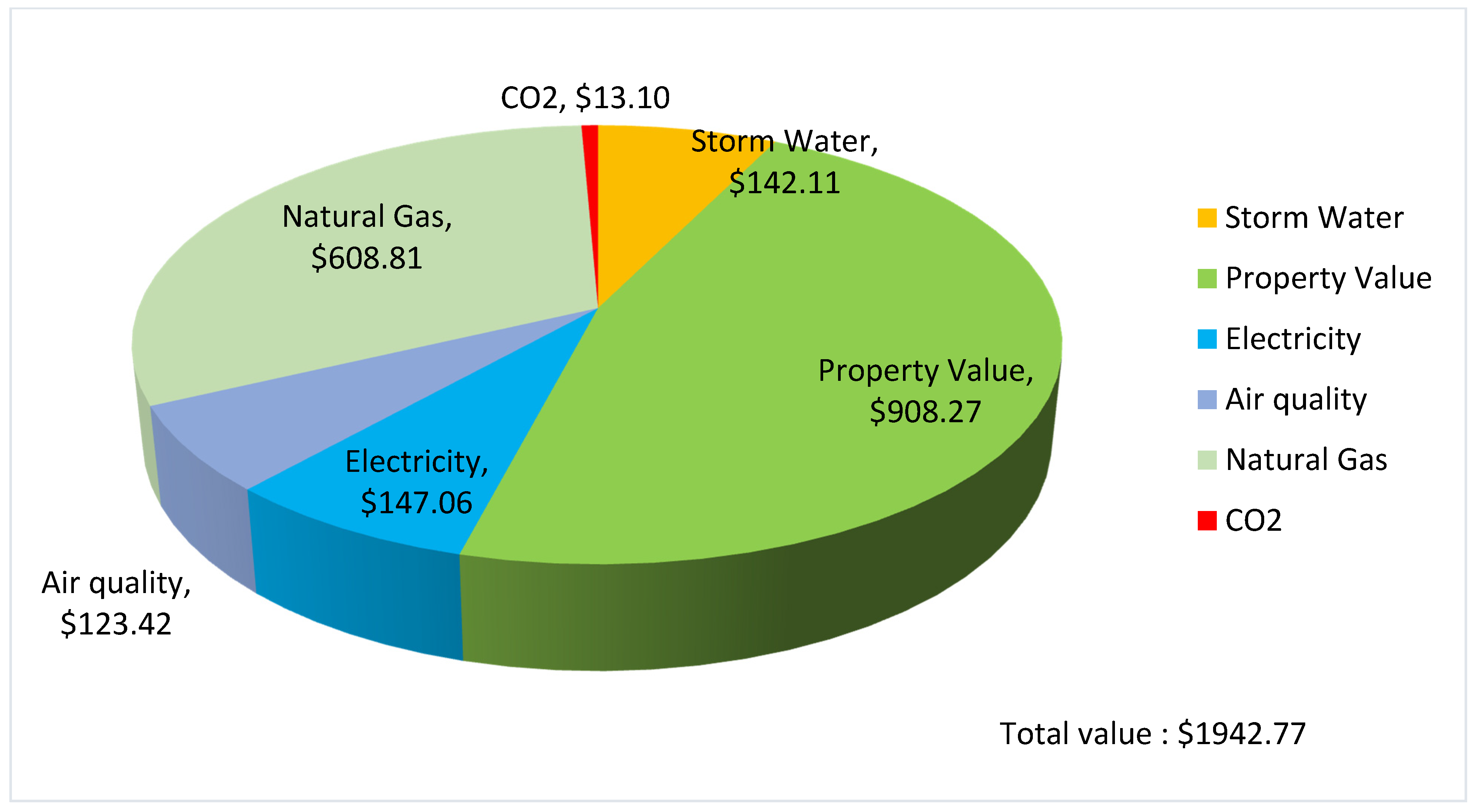
| Benefits | Details as Described in the NTBC, 2021 |
|---|---|
| Storm Water | Trees reduce urban storm water runoff (or “non-point source pollution”) by:
|
| Property Value | The NTBC uses a tree’s Leaf Surface Area (LSA) to determine increases in property values. A home with more trees (and a higher LSA) tends to have a higher value than one with fewer trees (and a lower LSA). |
| Energy | Trees reduce kilowatt hours of electricity for cooling and reduce the consumption of oil or natural gas. Trees modify the climate and conserve building energy use in three principal ways:
|
| Air Quality | Urban forests can mitigate the health effects of pollution by:
|
| CO2 | Trees can have an impact by reducing atmospheric carbon in two primary ways:
|
| Title | Costs (USD ) |
|---|---|
| Average cost of the large (12-inch DBH) ash tree | USD 325 |
| Replacement of ash tree cost | USD 325 |
| Removal cost | USD 45 per inch of DBH |
| Treatment cost | USD 5 per inch of DBH |
| Management Scenario | Net Present Value USD (0%) | Net Present Value USD (2%) | Net Present Value USD (5%) |
|---|---|---|---|
| No infestation (over 20 years) | 1942.77 | 1542.79 | 1126.13 |
| Infestation and no action (over 10, 15, 20-year horizon) | −2023.27, −3648.73, −5682.93 | −1793.37, −3047.89, −4470.45 | −1511.55, −2371.38, −3215.33 |
| Immediate removal and replacement (over 20 years) | −12,182.93 | −9784.67 | −7265.55 |
| Treatment (over 20 years) | 1095.47 | 874.65 | 643.75 |
| Management Scenario | Net Loss Value USD (0%) | Net Loss Value USD (2%) | Net Loss Value USD (5%) |
|---|---|---|---|
| No infestation (over 20 years) | 0 | 0 | 0 |
| Infestation and no action (over 10, 15, 20-year horizon) | −2782.35, −4946.40, −7625.70 | −2469.04, −4139.42, −6013.24 | −2084.65, −3229.69, −4341.46 |
| Immediate removal and replacement (over 20 years) | −14,125.70 | −11,327.46 | −8391.68 |
| Treatment (over 20 years) | −847.30 | −668.14 | −482.38 |
Publisher’s Note: MDPI stays neutral with regard to jurisdictional claims in published maps and institutional affiliations. |
© 2022 by the authors. Licensee MDPI, Basel, Switzerland. This article is an open access article distributed under the terms and conditions of the Creative Commons Attribution (CC BY) license (https://creativecommons.org/licenses/by/4.0/).
Share and Cite
Arbab, N.; Grabosky, J.; Leopold, R. Economic Assessment of Urban Ash Tree Management Options in New Jersey. Sustainability 2022, 14, 2172. https://doi.org/10.3390/su14042172
Arbab N, Grabosky J, Leopold R. Economic Assessment of Urban Ash Tree Management Options in New Jersey. Sustainability. 2022; 14(4):2172. https://doi.org/10.3390/su14042172
Chicago/Turabian StyleArbab, Nazia, Jason Grabosky, and Richard Leopold. 2022. "Economic Assessment of Urban Ash Tree Management Options in New Jersey" Sustainability 14, no. 4: 2172. https://doi.org/10.3390/su14042172
APA StyleArbab, N., Grabosky, J., & Leopold, R. (2022). Economic Assessment of Urban Ash Tree Management Options in New Jersey. Sustainability, 14(4), 2172. https://doi.org/10.3390/su14042172





